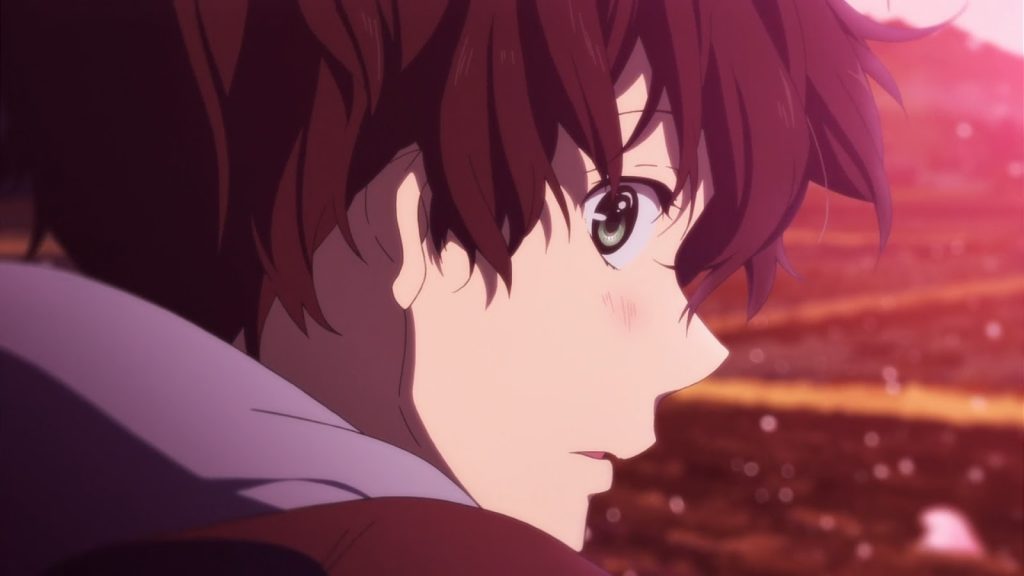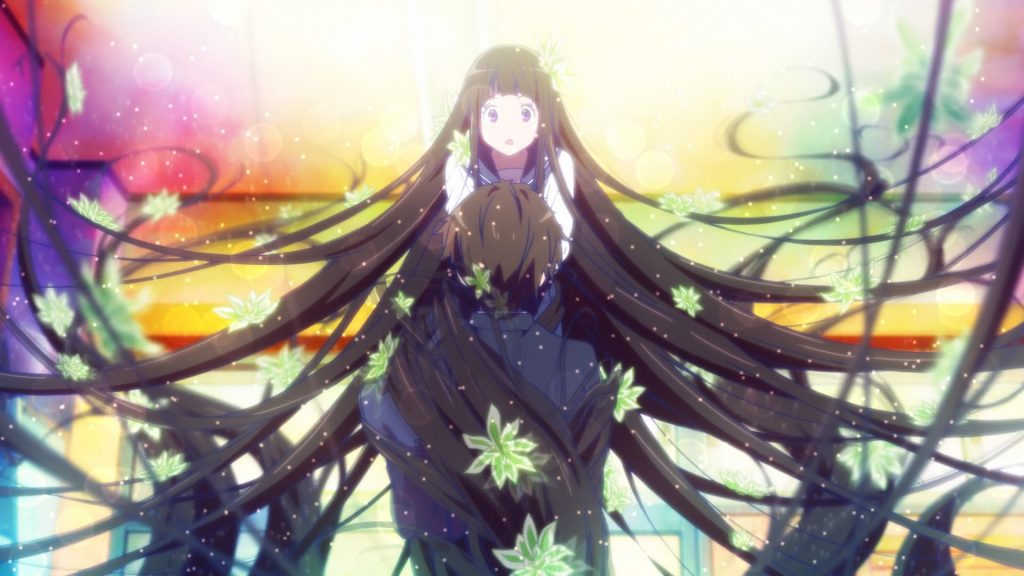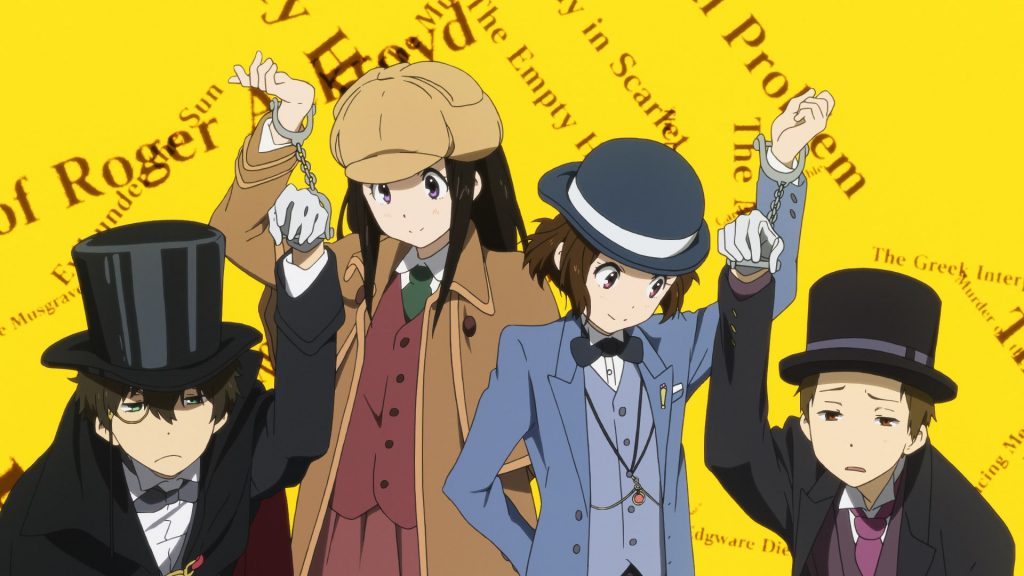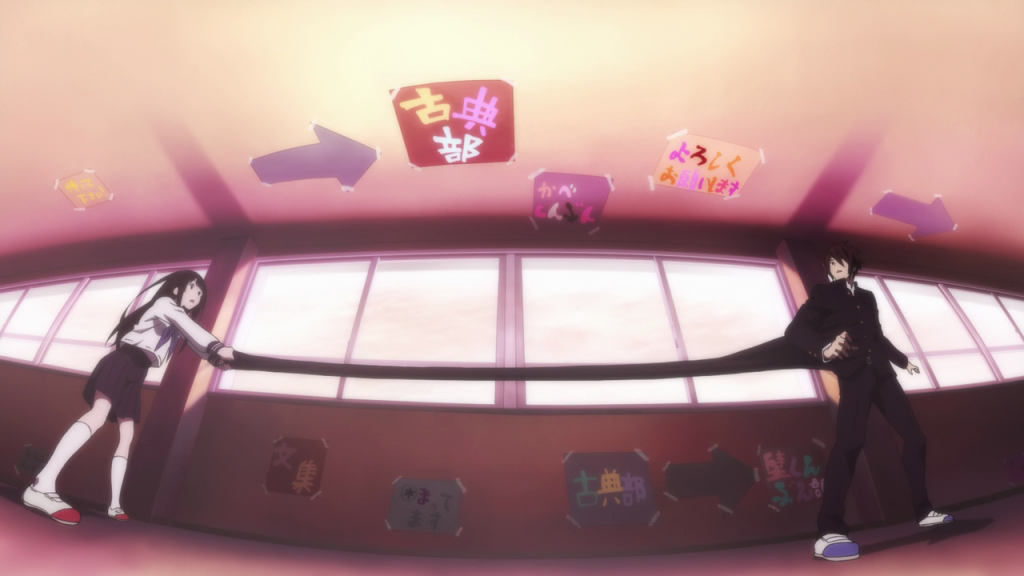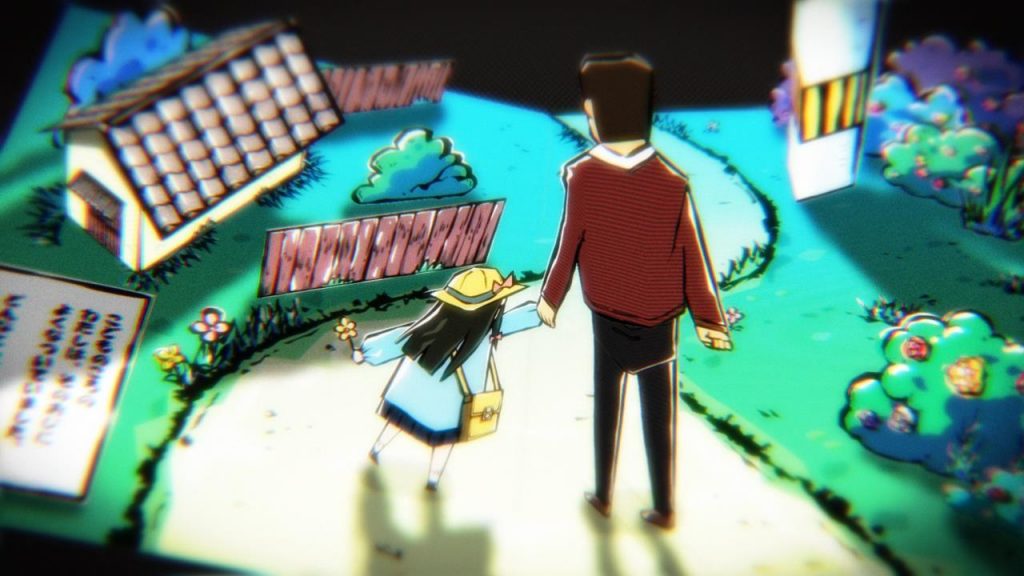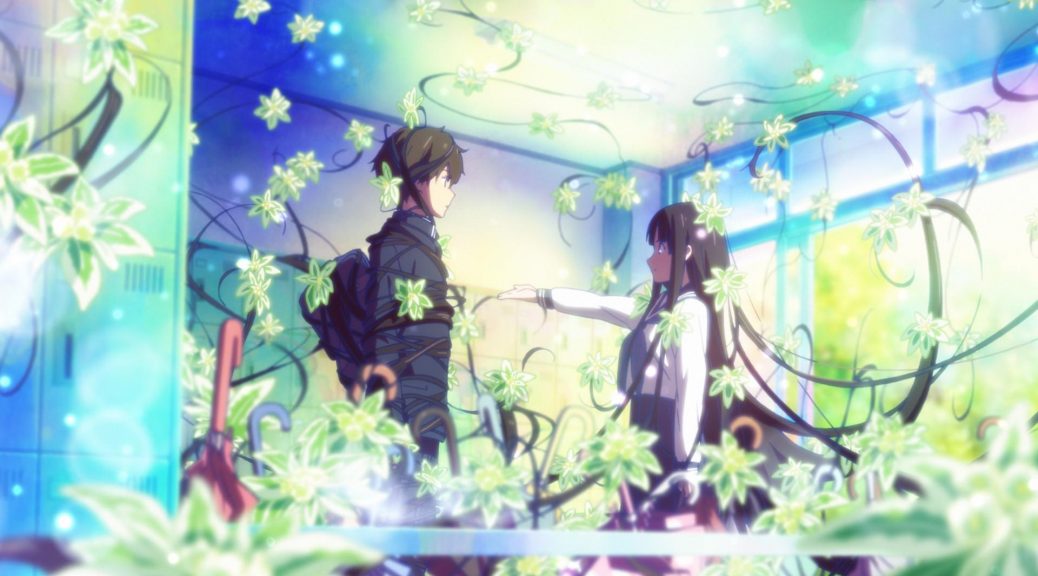
Hyouka Roundtable: Yasuhiro Takemoto x Shouji Gatou, Otona Animedia #5 2012 (Part 1)
The Hyouka anime adaptation is celebrating its 5th anniversary, and just today its live action movie adaptation has officially started screening. The reception of that film appears to be mixed at best, but that’s still a good chance to look back on a very special show. For the next week we’ll be having daily translations of interviews with the show’s staff, starting the only way we could: with the series directorSeries Director: (監督, kantoku): The person in charge of the entire production, both as a creative decision-maker and final supervisor. They outrank the rest of the staff and ultimately have the last word. Series with different levels of directors do exist however – Chief Director, Assistant Director, Series Episode Director, all sorts of non-standard roles. The hierarchy in those instances is a case by case scenario. Yasuhiro Takemoto and his good writing pal Shouji Gatou; they’re not only a talented crew but also friends with great chemistry, so enjoy their casual yet insightful look at the production of the series – how the project came to be, the process to adjust to the series’ particular tone, the changes in the adaptation, the rationale behind the design work and much more. This one is so long we had to split it in two!
Yasuhiro Takemoto – Anime series directorSeries Director: (監督, kantoku): The person in charge of the entire production, both as a creative decision-maker and final supervisor. They outrank the rest of the staff and ultimately have the last word. Series with different levels of directors do exist however – Chief Director, Assistant Director, Series Episode Director, all sorts of non-standard roles. The hierarchy in those instances is a case by case scenario., animator, unit director. Member of Kyoto Animation’s Board of Directors. Notable works include Full Metal Panic? Fumoffu, High Speed!, and The Disappearance of Haruhi Suzumiya, among others.
Shouji Gatou – Author, script writer. In charge of the series compositionSeries Composition (シリーズ構成, Series Kousei): A key role given to the main writer of the series. They meet with the director (who technically still outranks them) and sometimes producers during preproduction to draft the concept of the series, come up with major events and decide to how pace it all. Not to be confused with individual scriptwriters (脚本, Kyakuhon) who generally have very little room for expression and only develop existing drafts – though of course, series composers do write scripts themselves. for Hyouka. Notable works are the Full Metal Panic! series, The Melancholy of Haruhi Suzumiya (scriptwriting) and Amagi Brilliant Park.
─ How was the Hyouka anime project initiated?
Takemoto: At first, one of the producers from this company (Kyoto Animation) proposed to turn this work into an anime, and so we received copies of the novels. Then I raised my hand and said I wanted to direct it – that’s how it all began.
Gatou: Afterwards, it seems like there was the question of who should do the series compositionSeries Composition (シリーズ構成, Series Kousei): A key role given to the main writer of the series. They meet with the director (who technically still outranks them) and sometimes producers during preproduction to draft the concept of the series, come up with major events and decide to how pace it all. Not to be confused with individual scriptwriters (脚本, Kyakuhon) who generally have very little room for expression and only develop existing drafts – though of course, series composers do write scripts themselves., so they got in contact with me.
Takemoto: That’s right. The one who requested Gatou-san to be the series composer was me.
─ Were you asked by the director in person?
Gatou: At times like that, the custom is to receive the offer the formal way through the company, although in this case Takemoto-san and I are something like drinking buddies (laughs). That said, I did receive the offer formally during work and replied that I would do it. I’m glad the director invited me.
─ Please tell us your impressions when you read the novel.
Takemoto: Maybe “thorn” is a fitting term. I was very attracted to the bittersweet parts and thought that I would really like to turn this into an anime.
─ Do the bittersweet bits occur as a consequence of the characters’ youthfulness?
Takemoto: Yes. Part of it comes from their youthfulness, but also from the crampedness of the world they’re living in. This is by no means a show where raw emotions collide with each other. It’s hard to phrase it… It’s a story about the Classics Club quartet getting entangled in various incidents and settling them together; however, in the end it still doesn’t quite feel like everything was completely resolved. How should I put it…
Gatou: That depressing feeling is still there.
Takemoto: That’s true. I found the thorn piercing you in the heart kind of nice after that. It seems like I might be a gloomy person myself (laughs).
Gatou: Takemoto-san particularly stressed that element in this project. I always knew that he was a pessimist (laughs).
Takemoto: It somehow feels like there’s a part of me that grins when witnessing a human’s wicked side (laughs). I was incredibly attracted to the grim facet of this work.
Gatou: When I saw the title Hyouka for the first time, I wondered if it was a horror mystery or something. Once I had started it, I was confused about how I should read it; I believe that, when it comes to the mystery genre, it’s common to emphasize the question “Why did you do this?” but in my case, all I write are stories about the question “How are you going to do this?“… In other words, they’re the Pow! Pow! kind (laughs). Viewing it from this sort of perspective, there were bits where I couldn’t comprehend why someone would fuss over such a thing. However, that is one of its charms that‘s possible to enjoy it once you change your mannerisms, or rather your way of reading. In my case, it was quite difficult to find that shift. Well, I say that but it took me around 10 minutes to get used to it (laughs). But really, I thought that it was a novel only an avid reader would pick. I’ve been reading it ever since I heard about its adaptation so I expected there to be pros and cons once it got animated. But I believed it was such an excellent novel that it was worth taking the risk.
Takemoto: There were also people who found it plain…
Gatou: To be frank, it is plain (laughs).
Takemoto: Both the critics and the fans think it’s plain, don’t they? (laughs).
─ It’s a mystery work but there aren’t any flashy cases such as murders. Did you have any concrete image in mind for the anime adaptation beforehand?
Takemoto: I didn’t!
Gatou: How outrageous (laughs).
Takemoto: Though I did think it was a gentle and entertaining story, and personally, I was quite hooked on it so I guessed it should be fine if I thought about its visualization at a later time. I just replied that I would like to be the director.
Gatou: I wondered if there might be a good chance of success when it’s Yasuhiro Takemoto and I. I thought there might be some kind of vision but turns out there wasn’t any (laughs).
─ Then your vision was developed later on during the scenario meetings and so forth.
Takemoto: Exactly. That’s why I didn’t do it on my own but developed the idea during discussions with many people.
Gatou: We were basically just fumbling with everything, including the scenario. I was only playing the observer role when it came to the characters at that time though. That’s why they might be a bit awkward in the early stages. We were also hesitant with the scenario because of the source material…
─ Such as the question of how much you should arrange the novel’s contents?
Gatou: It was around the time of the End Credits of the Fool arc that we became able to rearrange material without any hesitation.
Takemoto: Everyone struggled while grasping the characters when we were working on the first Hyouka arc.
Gatou: At the beginning, I was worried that they might be too plain so I came up with considerably modified versions of the characters as well. I wrote a lot of dialogue where Eru would be more of a foolish and bothersome girl, while Houtarou was pushed around by her and would immediately retort with something along the lines of “No way I can do that!” and so on… However, I turned away from those versions by myself. I thought they wouldn’t fit in the end. Making the characters a bit more dignified was for the better.
Takemoto: I wasn’t worried about the dignified part. However, I definitely wanted to express the bittersweetness – that “thorn” present in the source material – so that was what I focused on when we were constructing the characters. But I have a feeling that I made tons of requests to many people due to that (laughs).
Gatou: Takemoto-san’s image of Houtarou and Chitanda had that taste of gloominess but there was no way everyone could grasp everything right at the beginning, so there were times when Takemoto-san asserted “My Houtarou wouldn’t say such a thing!“, whereas I replied with “My Houtarou does say such things though!“.
─ Each one of you had his own concept, didn’t you? (laughs)
Gatou: This time, however, I decided to act more as catcher than a string-puller – so it was more of a case of me going along with Takemoto-san’s requests. I gradually came to understand that as we reached the second half of the show.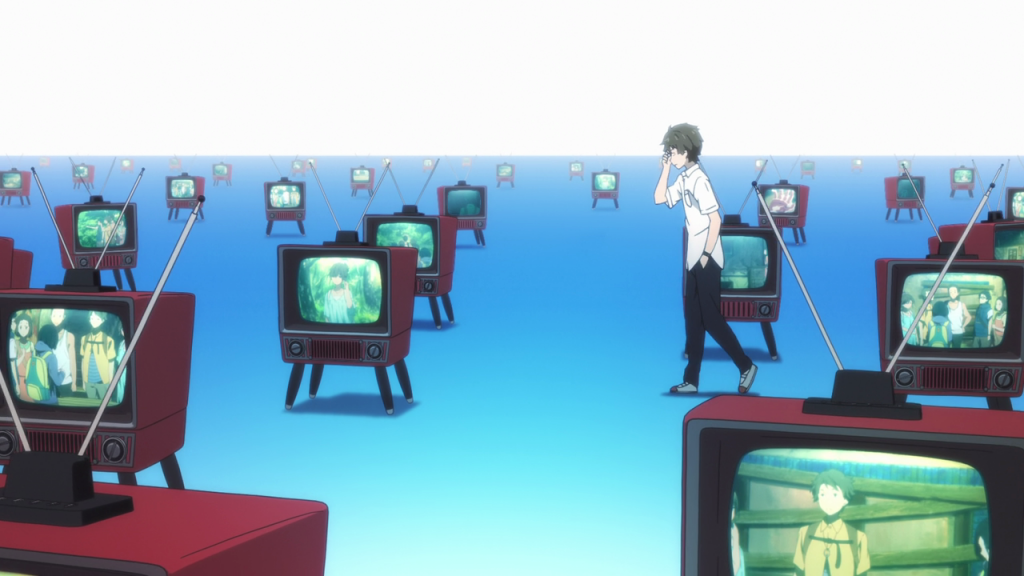
─ I see. Did the characters have visuals when you started the series compositionSeries Composition (シリーズ構成, Series Kousei): A key role given to the main writer of the series. They meet with the director (who technically still outranks them) and sometimes producers during preproduction to draft the concept of the series, come up with major events and decide to how pace it all. Not to be confused with individual scriptwriters (脚本, Kyakuhon) who generally have very little room for expression and only develop existing drafts – though of course, series composers do write scripts themselves. and writing scripts?
Gatou: No, there weren’t any designs yet. Generally, it’s very rare to have actual anime art right at the start for a project with existing source material, and I believe it’s the norm to begin with the scenario. Of course, the voice cast hadn’t been decided on yet either and we didn’t have any illustrations at hand so all I had envisioned in my mind were the characters’ gloomy faces.
Takemoto: It wasn’t until halfway into the scenario writing that the designs were finished.
─ In that case, did you grasp the images for the characters and your visions for the show once you had the visuals?
Gatou: I firmly grasped Houtarou’s image just recently actually, namely around the time the novel’s Hyouka arc ends in episode 5 (laughs). The animation was finished, the voice actors were chosen, it got dubbed and I watched the finished footage; it was only then when I truly came to realize what sort of show it is. How was it in your case, Takemoto-san?
Takemoto: The visual production started around the same time as the scenario’s, and character designer Futoshi Nishiya-kun and I were working on it for a really long time. We ended up being late at presenting the results to the other staffers. I had received many other variations from Nishiya-kun too, but I could have promptly settled on one since he had come up with quite good character designs since the outset.
─ What kind of variations?
Takemoto: For example, there was a draft where Houtarou didn’t have naturally curly hair and another one where he wore glasses. However, I personally thought it would be nice if his hair fell around his eyes and, depending on the angle of his face, his eyes got obscured and weren’t visible anymore.
Gatou: You said that at quite an early stage, didn’t you?
Takemoto: I wanted to bring out an unkempt feeling, since I wanted to make him cute. Once I suggested “How about curly hair?“, his current design – that I found adorable – was born.
─ You wanted to portray Houtarou in a cute fashion, didn’t you?
Takemoto: Correct. Afterwards, the finished design looked adult-like at first so I insisted “This guy was in 9th grade just a month ago“. I told Nishiya-kun to make him feel younger, not so long-proportioned and less long-faced.
Gatou: Houtarou’s speech and conduct are very mature in the source material so that bugged me at first.
Takemoto: Houtarou’s voice actor Yuuichi Nakamura-san said that too. When he saw the anime’s character art after reading the first Hyouka volume, he told me it wasn’t quite what he expected. Houtarou gives off a mature impression in the source material but I assumed he would be more childish, more hesitant and more anguished, so that was an intentional choice.
Gatou: There’s a big gap, isn’t there? For example, he gets flustered whenever Eru suddenly draws closer to him. I guess that’s part of the direction Takemoto-san is thinking of. I’m the type of person who’d object to that though. I’d just suggest stuff like making him cooler (laughs).
─ There’s that part too so I get the impression Houtarou’s image is a bit different from the novel.
Gatou: It’s quite different, isn’t it? When I was reading the source material, Houtarou gave me the impression of an unattractive boy but the anime’s Houtarou is fairly alluring.
Takemoto: Great, isn’t it? (laughs)
Gatou: Yes, it’s great (laughs).
─ So it went just as Takemoto-san had intended.
Gatou: That was a good move, wasn’t it? Well done! Though I didn’t even do anything (laughs).
Takemoto: There are also scenes where Houtarou still has bed hair and I thought it’d be a shame if we couldn’t take advantage of it.
Gatou: There’s a scene in episode 7 where he pushes back his bangs in the hot springs, right? That’s a really terrific weapon (laughs).
Takemoto: His forehead?
Gatou: Yep. When you see something that’s usually hidden, it gives you this feeling of “Argh, WOOOO!” you know! Even I get this worked up over his bathing scene (laughs).
Takemoto: Isn’t that “WOOOO!” from Hentai Kamen? (laughs)
Gatou: It’s from Hentai Kamen Inari Sushi (laughs).
─ It’s thanks to all the love both of you poured into it that Houtarou became this alluring, isn’t it!? Well then, what about Eru Chitanda?
Takemoto: Eru was the most difficult character. Is this what you call being pigeonholed into the classy lady with long black hair trope?
Gatou: There are just too many attributes.
Takemoto: She’d have definitely been overshadowed if we had taken that cliched route so I asked Nishiya-kun to give her a more simplified design. I also told him not to make her design look that stereotypical. I had him pay attention to the silhouette of her hair or the size of her eyes – I suppose that’s how we somehow were able to step away from the classy lady with long black hair trope and create the character Eru Chitanda.
Gatou: It feels like she turned out feeling younger than in the source material, just like Houtarou. One thing I stubbornly insisted on was to secretly give her a big chest, discreetly (laughs). I have a feeling I kept saying over and over again that I wanted to have her look slender in clothing but I don’t know if that had any influence (laughs).
Takemoto: Eru’s chest is big though?
Gatou: It really is better for her to be well-endowed, isn’t!? However, to my surprise she ended up feeling cuter than beautiful. Yonezawa-sensei’s image of her in the novel might have been that of a classier girl. There are quite a lot of classy girls in his novels, aren’t there?
Takemoto: There seems to be a fan theory that Yonezawa-sensei might have a thing for classy girls actually.
Gatou: Eru is the daughter of a high-class family but she isn’t the kind of character who acts gracefully and is hard to approach – she’s a really friendly character. There was something I wanted to insert in the scenario but eventually withdrew from, and I wonder if we managed to convey that visually. If we had portrayed her as a foolish and bothersome girl with that character design like I’ve mentioned earlier, then she would’ve turned out annoying for sure. That’s why I believe she’s fine the way she is now.
─ Next, what is your image of Satoshi Fukube?
Takemoto: Satoshi is a character you can relate to.
Gatou: I can’t relate to him (laughs).
Takemoto: How should I put it… Satoshi is a regular person. He represents the ordinary people.
Gatou: It doesn’t look that way at first glance, though.
Takemoto: However, the feelings he’s harboring, the various parts inside of him that he’s hiding behind his smile and won’t show to anyone, are emotions and complexes that ordinary people naturally possess. That’s why I have very strong feelings for Houtarou but the one I personally empathize with is Satoshi. I thought “I truly understand how you feel“. For this reason, I can see the viewers feel close to Satoshi in one way or another too.
Gatou: I like Satoshi but I can’t empathize with him at all so I guess we’re complete opposites (laughs). Satoshi is an amusing boy and I think he has an interesting personality, though. However, I can’t help but think “There’s no point in saying such things, is there?” when it comes to the melancholic feelings he’s harboring (laughs).
Takemoto: Only strong people can say that!
Gatou: It turns into that sort of discussion in the end, doesn’t it? I often get called out by Takemoto-san ala “You’re strong so it’s easy for you to say that“.
Takemoto: (laughs).
─ Regarding the particulars of Satoshi’s design, were there any requests you asked from Nishiya-san?
Takemoto: We agreed on a more androgynous appearance for him. I also asked him to make Satoshi about as cute as Houtarou.
─ Did you use “cuteness” as the basis, director?
Takemoto: Yes. However, Satoshi’s finished design didn’t actually look all that androgynous. If anything, he was closer to a high-spirited boy, but I thought that spiky hair of his was cute too. And since that design was really popular with the female staffers too, we decided to go with it.
Gatou: Takemoto-san often asks them for their opinions.
Takemoto: I believe that to some degree, there are aspects to men and women that are different after all.
Gatou: I guess there are also things you just can’t imitate.
Takemoto: Exactly. That’s why I always think to myself that I should directly listen to what the women at the studio say.
─ Speaking of Satoshi, the pouches he always carries with him are adorable, with all of their various designs.
Takemoto: True. That part was already included in the source material so we decided to use that as his trademark in the anime. Anyhow, Satoshi is a moody person so we assumed he wouldn’t own just one or two pouches. For this reason, I asked prop designer Hiroshi Urata-san to create lots of multicolored pouches. Satoshi carries a different one with him almost every time.
Gatou: The huge number of his pouches will be revealed in the distant future. Look forward to them when Satoshi’s room appears!
─ That does make me curious.
Gatou: Satoshi also owns a smartphone and there are tons of apps on it I bet (laughs).
Takemoto: His phone screens and so on are probably different every time you look at it as well (laughs).
Gatou: Yeah, they’re different every time.
Takemoto: He’s that sort of kid.
Gatou: Houtarou would just leave the default one on all the time if he owned a cell phone I guess.
Takemoto: Actually, I don’t think he’d even think about owning one. At his core, he is the type of person who won’t get involved with people by his own accord so there is no need for the ultimate tool called the mobile phone.
Gatou: That’s true. I would rather not carry one with me either (laughs).
─ (laughs). As for cell phones, Eru doesn’t have one either, does she?
Takemoto: She doesn’t have one either.
Gatou: Though I don’t really get why she doesn’t. Is it a house rule?
Takemoto: Could be. Ah, no, maybe it’s more personal. I have a feeling Eru wouldn’t possess one out of her own policy. I think if she said she wanted one, then she’d receive it.
Gatou: Yeah, it’s not that much of a strict household.
Takemoto: I suppose Eru has principles about how to deal with people in her own way.
Gatou: Such as “It’s not good to communicate everything through texting” I guess?
Takemoto: Something like that for example.
Gatou: It does make you worry. She has that sort of personality and doesn’t own a cell phone; I feared that she didn’t have any friends. But I was at the recording of episode 14 today and it looked like she does have buddies, so I was relieved. I was worried that she would always be completely alone, you see.
Takemoto: You mean like having lunch in the restroom?
Gatou: Eru doesn’t seem like she’d have lunch in a restroom. She’d sit there in the open all by herself I guess.
Takemoto: Isn’t that brave actually? (laughs).
Gatou: Sorry, we went off on a tangent there (laughs).
─ (laughs). Continuing with Mayaka, what kind of image did you have of her?
Takemoto: Apart from Mayaka’s shortness, there wasn’t any other remark about her appearance in the novels so Nishiya-kun and I decided to design her freely. Her hairstyle has essentially stayed the same all this time, but since Nishiya-kun said that he wanted to show her forehead, I gave him an OK (laughs).
Gatou: I had imagined Mayaka with long hair, to be honest. But that was just my personal visualization so when her design was finished, I realized “Oh, so that’s how it is. She has short hair, I wasn’t aware!“.
Takemoto: She’s small but proactive. Also, she’s the closest to an ordinary high schooler.
Gatou: She’s the most normal person actually (laughs).
Takemoto: She often says malicious things though.
Gatou: We’ve already made her a lot milder (laughs).
Takemoto: True. We were careful to portray her in an endearing manner so she wouldn’t come off as too harsh and unlikable. We also coupled her with Ai Kayano-san’s voice so she would be forgiven despite her harsh words.
Gatou: Cute, isn’t she?
Takemoto: And then Mayaka’s casual clothes were made to look awfully lovely. I got the impression that drawing all those was fun for Nishiya-kun too. Mayaka can wear anything and it’ll suit her.
─ When I had a talk with with the soundtrack composer Kouhei Tanaka-san, he told me that Mayaka was cuter than he had expected.
Gatou: It’s because she’s bitter toward Houtarou so she comes off as harsh.
Takemoto: This is a nuance I had sensed in the source material and it’s something I wanted to express, but she isn’t only harsh or mean to him. There’s a part of her that acknowledges Houtarou.
Gatou: That was something we didn’t want to forget.
Takemoto: Mayaka does acknowledge that a certain part of Houtarou is amazing but that’s precisely the reason why she doesn’t want to lose to someone who usually just lazes around, and I think she sees him as something like a rival.
Gatou: Judging by the discussion I had with Yonezawa-san, the reason behind Mayaka’s attitude toward Houtarou has to do with something that happened in their middle school days.
─ Next, I would like to ask you about the series compositionSeries Composition (シリーズ構成, Series Kousei): A key role given to the main writer of the series. They meet with the director (who technically still outranks them) and sometimes producers during preproduction to draft the concept of the series, come up with major events and decide to how pace it all. Not to be confused with individual scriptwriters (脚本, Kyakuhon) who generally have very little room for expression and only develop existing drafts – though of course, series composers do write scripts themselves. as well as the scenario. In episode 1, there were not only stories from the Hyouka novel but also a story from the Doll That Took A Detour novel, wasn’t there?
Gatou: You’re referring to the short story “If I Have To Do it, I’ll Make It Quick“, right? I forcefully inserted that into episode 1. I arranged the novels’ stories chronologically but the first episode’s second half was the only opportunity to include that tale.
Takemoto: We wanted to arrange the material chronologically from the beginning, you see.
Gatou: When we published a few stills from the first episode long before the actual broadcast, there was a person who had already seen right through us and guessed that the story “If I Have To Do it, I’ll Make It Quick” was included in the first episode because the color of Satoshi’s shirt was different so it had to be the next day, which took us by surprise. What a keen eye (laughs).
Takemoto: They were completely right (laughs).
Gatou: We can’t let our guard down (laughs).
Takemoto: Since it’s a mystery, we steeled ourselves so we wouldn’t spoil anything though.
─ The short stories from the collection The Doll That Took A Detour were included in episodes 6 and 7 too.
Gatou: That’s right. Chronologically seen, the story in episode 6 “Committing A Grave Sin” happens during the Hyouka case. However, Hyouka’s story would become harder to understand if you placed it there, which is why I relocated it.
─ I regard the visual direction in this work as one of the things that make it so charming. Was it all following the series director’s vision?
Takemoto: The daily life portions, or should I say the real life parts, ended up feeling… dry? How should I say it…
Gatou: Plain.
Takemoto: Yeah, they are plain (laughs). We portray ordinary school lives often so I wanted to add some spice to the visuals on top of that. So we came up with the idea to apply that to the portrayal of the characters’ emotions and the explanation segments during a case. I wanted those imaginative scenes to be visualized freely so I basically entrusted them to each episode director. I wanted them to come up with unrestrained concepts, including techniques that aren’t confined by 2D animation, and try out all sorts of ideas.
─ The part in episode 1 where Eru’s hair grows longer leaves a strong impression.
Takemoto: I worried about that scene quite a lot. I was at my wit’s end.
Gatou: It’s a bit scary (laughs).
Takemoto: Scary, isn’t it? I thought “Let’s do this“, scariness included. It’s scary, beautiful and mysterious.
Gatou: Mysterious.
Takemoto: Not mysterious as in “shady” but as in “bewitching” (laughs).
Gatou: So it’s not mysterious as in “fishy“.
Takemoto: That’s right (laughs).
─ What were your plans on how to portray their daily lives?
Takemoto: I didn’t have any in particular. This might sound strange but this company has been producing that sort of show since forever, so it was only natural for everyone that we would depict those even without being told so (laughs). That’s precisely why I did my absolute utmost to explain the portrayal of emotions or the imaginative scenes – and not the portrayal of daily life – to the other staffers.
─ The portrayal of daily life is your field of expertise so there was no need to spell it out I assume.
Takemoto: Exactly, everyone will get down to it after just a few words.
Gatou: That’s honestly what I believed when I looked at it. Everyone seemed so familiar with that register. Thoughts like “Woah, this movement is so outrageous” or “The one who came up with this scene must be a maniac (a compliment, really)” went through my head.
─ “Maniac” (laughs). Well then, please tell us which scene you two found memorable.
Gatou: Houtarou’s bathing scene (laughs).
Takemoto: Yes, that’s right. Episode 7 had a lot of impact.
─ The hot springs story in episode 7 became a hot topic in more ways than one.
Gatou: Nobody expected it to be this sort of hot springs episode I bet. And why do I find it so charming!? (laughs).
Takemoto: The steam will be removed in the Blu-ray version (laughs).
Gatou: Even if you removed the steam, all you could actually see is a boy’s behind. There’s a bit of female sex appeal too, though.
Takemoto: Personally, I also quite like episodes 10 and 11.
Gatou: You mean the scene where Houtarou’s heart gets broken.
Takemoto: It’s the first time Houtarou is outclassed.
Gatou: From my perspective, I have to question if that really was him being outclassed though. He was effortlessly used, but isn’t that fine? The movie got completed after all (laughs). Granted, he disregarded Hongou’s feelings altogether, but there’s no problem with that since they’re complete strangers (laughs).
Takemoto: We never get to know about Hongou’s sentiments until the end, true (laughs). Houtarou sees himself as gray and I believe there’s a part of him that always thinks he’s lacking something, that he wants to find that which he is lacking. In the End Credits of The Fool arc, he has the faint hope that he might be able to find and obtain that something, but he is totally and utterly betrayed. That was one of the things I wanted to illustrate.
Gatou: He was unexpectedly outwitted.
Takemoto: Exactly. We portrayed his anger and emptiness in episodes 10 and 11, which left a big impression on me.
Gatou: It’s not something that is bestowed on him by another person but something he seizes, or rather substantiates by himself, isn’t it? Maybe it’s a bit like how it should be yourself who decides for you and not someone else (laughs).
Takemoto: But it’s pretty harsh to expect that from a high schooler.
Gatou: Yeah, it’s harsh. You’re absolutely right.
─ The interpretation varies from person to person, doesn’t it?
Gatou: That’s what’s so great about this work. It’s fine to have people who think “Ice cream (I scream)? So what!?” and also those who get the chills when they hear it. I believe it’s a show where the interpretation, including that of the characters’ emotions, varies depending on the person so there’s no problem if there are several opinions. That’s why I had to wonder if it was okay for me to say something cynical.
Takemoto: I think there are a lot of people like that (laughs).
Gatou: There really are!
Takemoto: I was surprised at how many there are.
Gatou: One of Eru’s lines (episode 9, before she passes out) is “It’s like a kaleidoscope” – wouldn’t you say the show itself is also like one? I said something really profound just now.
Takemoto: You sure? (laughs)
Gatou: What, you’re so mean~ (laughs). Please use this for a headline or something. Ah, but it’s also fine if you don’t.
Originally published in issue 5 of Otona Animedia 2012. Translated by Pen, who will be spearheading this special Hyouka project. Continues in Part 2.
Support us on Patreon to help us reach our new goal to sustain the animation archive at Sakugabooru, SakugaSakuga (作画): Technically drawing pictures but more specifically animation. Western fans have long since appropriated the word to refer to instances of particularly good animation, in the same way that a subset of Japanese fans do. Pretty integral to our sites' brand. Video on Youtube, as well as this SakugaSakuga (作画): Technically drawing pictures but more specifically animation. Western fans have long since appropriated the word to refer to instances of particularly good animation, in the same way that a subset of Japanese fans do. Pretty integral to our sites' brand. Blog. Thanks to everyone who’s helped out so far!

